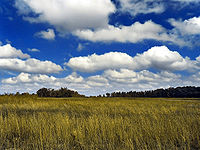
Photo from wikipedia
Stratocumulus clouds around the globe tend to organize into cellular patterns, a phenomenon that has been primarily studied for the subtropical trade wind region. However, stratocumulus are also prevalent in… Click to show full abstract
Stratocumulus clouds around the globe tend to organize into cellular patterns, a phenomenon that has been primarily studied for the subtropical trade wind region. However, stratocumulus are also prevalent in high latitudes, where they often occur as mixed-phase clouds. Yet little research has been conducted regarding mechanisms of cloud organization in the mixed-phase regime. In cloud-resolving model simulations we investigate the processes driving organization in open-cell mixed-phase stratocumuli. Similar to warm-phase clouds, mixed-phase clouds develop a subcloud circulation of evaporated/sublimated precipitation, cold pool formation, and consecutive updrafts driving new convective cells. For a larger ice to liquid water ratio, we find locally stronger precipitation and larger cloud cells. Hence, a higher concentration of ice nucleating particles can induce a breakup of the stratocumulus organization, with implications for the radiative balance at the surface. A decrease in cloud condensation nuclei concentration is also found to intensify precipitation and impact cloud organization. Plain Language Summary Low-lying clouds have been found to organize into honeycomb-like spatial patterns. This has been primarily studied for liquid clouds in the subtropical regions but has remained unexplored in the high latitudes. Previous studies focusing on precipitating open-cell clouds have found that below cloud base a continuous cycle of evaporation and subsequent latent cooling, sinking, and lateral spreading of the air mass can be observed. Colliding air masses push the air upward which leads to localized updrafts and new cloud formation. In this study, we explore the organization of open-cell polar clouds, which consist of both liquid cloud droplets and ice crystals (so-called mixed-phase clouds). We show that open-cell mixed-phase clouds also form honeycomb-like spatial patterns following the same mechanism as liquid clouds. However, the spatial extent of cloud patterns changes with the amount of cloud ice. Clouds that contain ice produce precipitation earlier and more intensively. As a result, the cooling below cloud base is strengthened and the cloud cells grow larger. This has implications for the radiative balance at the surface. The stronger growth of ice-containing clouds leads to a breakup of the organized structures, which increases the amount of outgoing radiation.
Journal Title: Geophysical Research Letters
Year Published: 2019
Link to full text (if available)
Share on Social Media: Sign Up to like & get
recommendations!